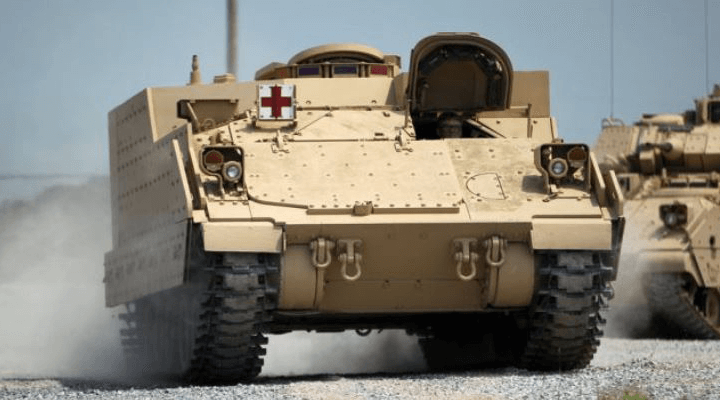The U.S. military is now investing significant resources to enhance its aging combat vehicle (CV) fleet, while also developing the next-generation of vehicles that will utilize autonomous technology and operate unmanned. These CVs will be able to follow an optionally manned vehicle leader, and will also be able to conduct intelligence gathering operations.
According to a recently released Frost & Sullivan report, ‘U.S. Military Combat Vehicle Market, Forecast to 2024,’ the development of robotics and autonomous systems will boost the combat effectiveness of these vehicles, while the convergence and integration of various sensors and weapons systems will provide new application opportunities.
All of this won’t come cheap. Frost & Sullivan expects the cumulative spending by the Department of Defense (DoD) on military CVs to reach $56.25 billion by 2024. The technology upgrades and modifications will account for the stable spending segments such as wear and tear of systems, and developing defense mechanisms for evolving threats will be an essential area of focus suggested John Hernandez, senior industry analyst for defense at Frost & Sullivan.
“The modernization of combat vehicles is being shaped to counter evolving threats while at the same time designed to offer more protection to ground troops,” Hernandez told ClearanceJobs.
He added that this could result to some extent in a major upgrade/update to the current U.S. arsenal. This is in part because weapons that were once the domain of science fiction are on the verge of becoming a reality.
“The development of directed energy weapons – both laser and electromagnetic – (as well as) the expanding sophistication of drones and robotics calls for new systems that can detect, overcome and defeat new technologies,” explained Hernandez.
The U.S. Army is already looking to develop more sophisticated sensors, and Hernandez noted that this includes long wave infrared (LWIR) sensors that will offer an extended field of view, and in addition will be capable of providing high-definition video to enhance situational awareness in support of military CVs.
Out With the Old
Even with a solid roadmap forward, not all of the U.S. arsenal of CVs will be put out to pasture in the coming years however.
“Some older vehicles are being upgraded, because for the time-being it’s the most efficient and cost-effective solution to handle immediate threats,” Hernandez told ClearanceJobs. “On the hand, the U.S. Army has already shown its intent to replace the HMMWV with Oshkosh’s Joint Light Tactical Vehicle (JLTV).”
However, that doesn’t necessarily indicate the U.S. military will scrap the entire fleet. And in addition many U.S. allies also continue to rely on U.S. military hardware.
“The HMMWV is still in great demand with several allied nations, and will continue to be maintained, upgraded and utilized by U.S. units until they can be exchanged out,” added Hernandez. “In addition, the platform will probably be utilized to conduct experimentation and testing in the development of the Next Generation Combat Vehicle that is supposed to have autonomous capabilities.”
Other vehicles could be seen as “relics” of the Cold War or otherwise don’t fit with the current needs of the military.
“The Bradley is also set to be replaced; however recent issues associated with missed deadlines have left only one company standing (General Dynamics) to compete for the contract,” said Hernandez. “Whether the Army will extend the deadline to let other competitors back in the mix may be viable in order to avoid any suggestion of partiality. However, rules are rules and with tight budgets, the ever looming threat of another continuing resolution the Army has every right to expect potential partners to perform tasks in a timely manner.”
Opportunities for Contractors
The Frost & Sullivan report also noted that from a competitive perspective, the top five participants accounted for 80% of total value of contracts awarded during 2018. Participants such as BAE Systems, General Dynamics and Oshkosh Defense compete on cost, performance, schedule, support, technology, reliability, contractor relationship and customer relations.
OEMs to contend in this highly established and consolidated market each will need to start restructuring their respective platforms with a greater focus on open architecture. This could include benchmarking with modular designs, and also providing integration with weapons developers to ensure that the fire control architecture for the new CVs can accommodate a variety of weapons systems to meet the Army’s desire for said modularity.
“Modularity, I believe is definitely critical and a must for any future CV,” said Hernandez. “The HMMWV and HEMTT (Heavy Expanded Mobility Tactical Truck) vehicles have been in service for some time because of their ability to easily be modified for different roles.
“The JLTV and the Army ground mobility vehicle were procured for their reconfigurable designs,” he added. “One platform that can serve in different roles simplifies training and sustainment. Finally modularity offers the user more options, and easy upgrades – not to mention that is also opens opportunities for other companies to enter into the supply chain.”




